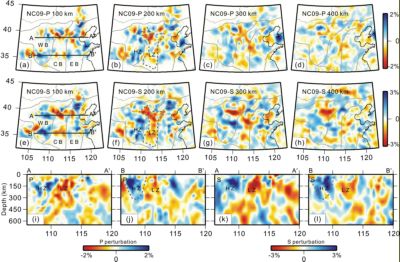Highlight 2009-030Update time:10 13, 2009
GEOPHYSICAL RESEARCH LETTERS, 2009,VOL. 36, L17306, doi:10.1029/2009GL039781 Reactivation of an Archean craton: Constraints from P- and S-wave tomography in North China Liang Zhao,Richard M. Allen,Tianyu Zheng,Shu-Huei Hung Abstract
The unusual reactivation of the North China Craton (NCC) challenges the classical views concerning the strength and stability of cratonic lithosphere. By using teleseismic body-waves recorded at 250 seismic stations, this paper presents high-resolution North China Models of P- and S-wave velocity based on finite-frequency kernel tomography. Both P- and S-wave velocity models reveal that: (1) an obvious N–S trending narrow low-velocity region is located at the base of the lithosphere beneath the Central Block (CB) of the NCC, which extends to more than 500 km depth; (2) a region of high-velocity extends to more than 250–300 km depth beneath the Western Block, in contrast to the much shallower high-velocity zones beneath the CB and shallower high-velocities beneath the Eastern Block. These features suggest that warm mantle material with a source at least as deep as the transition zone, possibly a mantle plume, may be responsible for the reactivation of the NCC. The Central Block may have behaved as a sublithospheric corridor for the warm mantle material due to its pre-existing weakness.
|
Contact
Related Articles
Reference
|
-
SIMSSecondary Ion Mass Spectrometer Laboratory
-
MC-ICPMSMultiple-collector ICPMS Laboratory
-
EM & TEMElectron Microprobe and Transmission Electron Microscope Laboratory
-
SISolid Isotope Laboratory
-
StIStable Isotope Laboratory
-
RMPARock-Mineral Preparation and Analysis
-
AAH40Ar/39Ar & (U-Th)/He Laboratory
-
EMLElectron Microscopy Laboratory
-
USCLUranium Series Chronology Laboratory
-
SASeismic Array Laboratory
-
SEELaboratory of Space Environment Exploration Laboratory
-
PGPaleomagnetism and Geochronology Laboratory
-
BioMNSFrance-China Bio-mineralization and Nano-structure Laboratory

 Print
Print Close
Close
